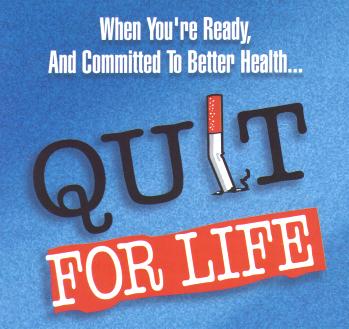

Editor's Note: Susan's approach to enticing students to quit smoking is both entertaining and informative. The article which follows was written for and published in the student newspaper at Monmouth University.
 Greetings, readers! My name is Susan Andrews and I am a staff nurse at
the Monmouth University Health Center. For the uninitiated, the Health
Center is located on College Place, a little to the left of the Library
and a little to the right of the dorms. Kind of a middle of the road
place, but not always, especially when it comes to taking care of
yourself.
We have some pretty strong beliefs in that old adage, "An ounce of
prevention is worth a pound of cure."
Greetings, readers! My name is Susan Andrews and I am a staff nurse at
the Monmouth University Health Center. For the uninitiated, the Health
Center is located on College Place, a little to the left of the Library
and a little to the right of the dorms. Kind of a middle of the road
place, but not always, especially when it comes to taking care of
yourself.
We have some pretty strong beliefs in that old adage, "An ounce of
prevention is worth a pound of cure."
Today, I'd like to talk about smoking, beginning with a definition of terms (derived from The Smoker's Addictionary by Roslyn Schwartz, adding a note of personal history, some information on effects of tobacco on the body and ending with useful application of this new found knowledge.
Definitions are as follows:
Inhale? Yes, I did, but not the first time. The first time I was about six. It was early fall. I was hiding behind our wooden garage, one loaded with those wonderfully flammable products-paint thinners, kerosene, gasoline, etc. I was with my brother Pete and our friend Jimmy. Pete being the eldest and ringleader, stole the matches and one of my mother's Pall Malls. No baby filter stuff back then. This was the real thing. We sat down on a pile of leaves and lit up. I don't recall how I felt physically after this first experience, but I do remember getting into deep trouble when we got caught, but let's not get into that. Fortunately, that garage is still intact and I managed not to add garage burning to my personal resume. During my college years, I did add "social smoker" to this resume but deleted this after the death of my Aunt Mary to lung cancer and my mother's incapacitation due to heart disease and stroke. For many years these two ladies were "partners in crime" taking one too many trips to Marlboro Country.
As noted above, you can see that tobacco use is harmful and often deadly. Users of tobacco become ill more often and suffer from many disabling conditions: lung and oral cancer, chronic obstructive lung disease, stroke, and heart disease. These debilitating conditions can be prevented if you don't light up. For men, cigarette smoking is the number one cause of cancer death. In 1987, lung cancer surpassed breast cancer as the leading cause of cancer deaths in women. Additionally, the latest research is pointing to a definite link between smoking and breast cancer. Despite the recent reports of general decline in smoking, we are seeing an alarming increase in the number of students who smoke or use tobacco on our campus.
So now that you know this , what can you do? These are some suggestions from the American Lung Association:
If you're interested in a smoking cessation program, please call the Health Center at extension 3464 or stop by.
If I have yet failed to convince you, go and meet the Ex-Winston Man on November 26th at the Warren Hotel in Spring Lake. He'll be the Guest Speaker for "One Stop Stopping." Call 223-6419 for pre-registration.

Return to Spring 1998 CQ
Menu
Return to Connections Quarterly Main
Menu